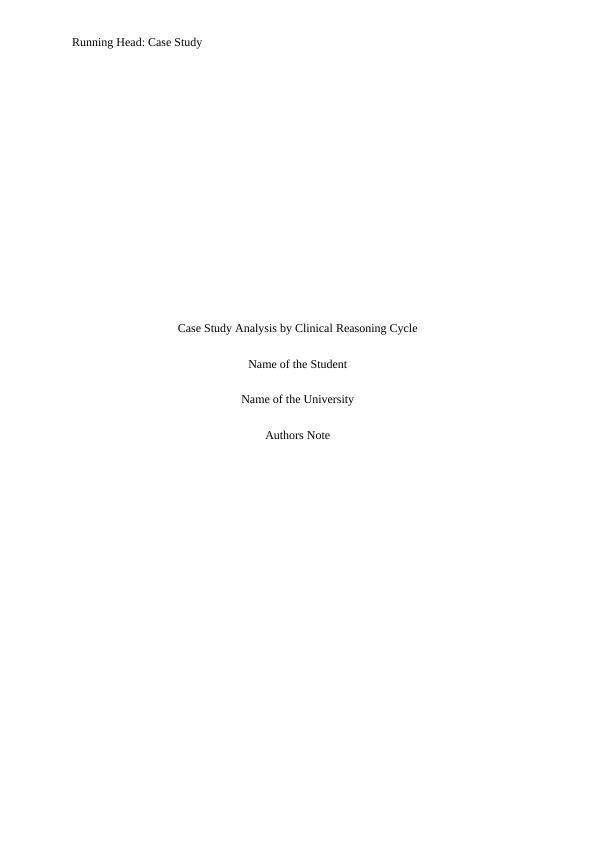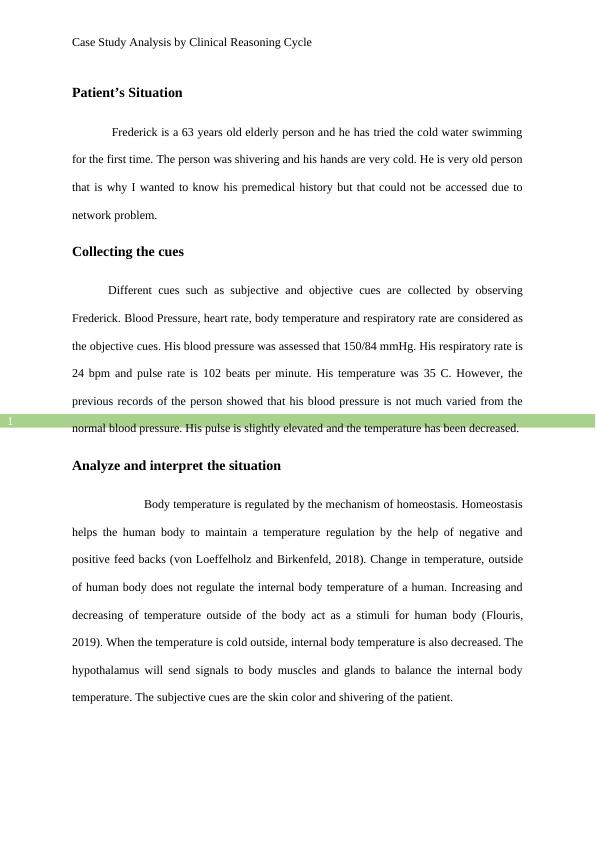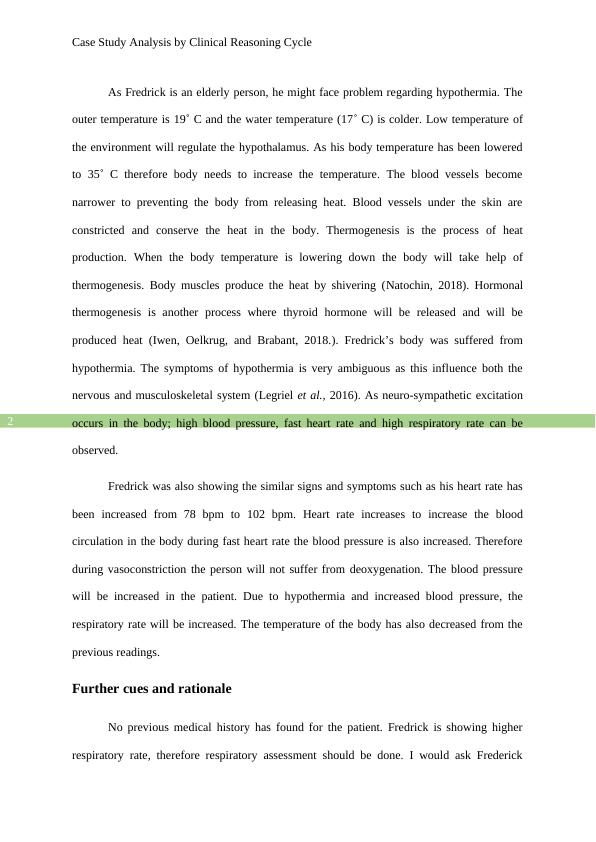Analysis by Clinical Reasoning Cycle
Added on 2022-09-14
6 Pages1488 Words23 Views
Running Head: Case Study
Case Study Analysis by Clinical Reasoning Cycle
Name of the Student
Name of the University
Authors Note
Case Study Analysis by Clinical Reasoning Cycle
Name of the Student
Name of the University
Authors Note

1
Case Study Analysis by Clinical Reasoning Cycle
Patient’s Situation
Frederick is a 63 years old elderly person and he has tried the cold water swimming
for the first time. The person was shivering and his hands are very cold. He is very old person
that is why I wanted to know his premedical history but that could not be accessed due to
network problem.
Collecting the cues
Different cues such as subjective and objective cues are collected by observing
Frederick. Blood Pressure, heart rate, body temperature and respiratory rate are considered as
the objective cues. His blood pressure was assessed that 150/84 mmHg. His respiratory rate is
24 bpm and pulse rate is 102 beats per minute. His temperature was 35 C. However, the
previous records of the person showed that his blood pressure is not much varied from the
normal blood pressure. His pulse is slightly elevated and the temperature has been decreased.
Analyze and interpret the situation
Body temperature is regulated by the mechanism of homeostasis. Homeostasis
helps the human body to maintain a temperature regulation by the help of negative and
positive feed backs (von Loeffelholz and Birkenfeld, 2018). Change in temperature, outside
of human body does not regulate the internal body temperature of a human. Increasing and
decreasing of temperature outside of the body act as a stimuli for human body (Flouris,
2019). When the temperature is cold outside, internal body temperature is also decreased. The
hypothalamus will send signals to body muscles and glands to balance the internal body
temperature. The subjective cues are the skin color and shivering of the patient.
Case Study Analysis by Clinical Reasoning Cycle
Patient’s Situation
Frederick is a 63 years old elderly person and he has tried the cold water swimming
for the first time. The person was shivering and his hands are very cold. He is very old person
that is why I wanted to know his premedical history but that could not be accessed due to
network problem.
Collecting the cues
Different cues such as subjective and objective cues are collected by observing
Frederick. Blood Pressure, heart rate, body temperature and respiratory rate are considered as
the objective cues. His blood pressure was assessed that 150/84 mmHg. His respiratory rate is
24 bpm and pulse rate is 102 beats per minute. His temperature was 35 C. However, the
previous records of the person showed that his blood pressure is not much varied from the
normal blood pressure. His pulse is slightly elevated and the temperature has been decreased.
Analyze and interpret the situation
Body temperature is regulated by the mechanism of homeostasis. Homeostasis
helps the human body to maintain a temperature regulation by the help of negative and
positive feed backs (von Loeffelholz and Birkenfeld, 2018). Change in temperature, outside
of human body does not regulate the internal body temperature of a human. Increasing and
decreasing of temperature outside of the body act as a stimuli for human body (Flouris,
2019). When the temperature is cold outside, internal body temperature is also decreased. The
hypothalamus will send signals to body muscles and glands to balance the internal body
temperature. The subjective cues are the skin color and shivering of the patient.

2
Case Study Analysis by Clinical Reasoning Cycle
As Fredrick is an elderly person, he might face problem regarding hypothermia. The
outer temperature is 19 ̊ C and the water temperature (17 ̊ C) is colder. Low temperature of
the environment will regulate the hypothalamus. As his body temperature has been lowered
to 35 ̊ C therefore body needs to increase the temperature. The blood vessels become
narrower to preventing the body from releasing heat. Blood vessels under the skin are
constricted and conserve the heat in the body. Thermogenesis is the process of heat
production. When the body temperature is lowering down the body will take help of
thermogenesis. Body muscles produce the heat by shivering (Natochin, 2018). Hormonal
thermogenesis is another process where thyroid hormone will be released and will be
produced heat (Iwen, Oelkrug, and Brabant, 2018.). Fredrick’s body was suffered from
hypothermia. The symptoms of hypothermia is very ambiguous as this influence both the
nervous and musculoskeletal system (Legriel et al., 2016). As neuro-sympathetic excitation
occurs in the body; high blood pressure, fast heart rate and high respiratory rate can be
observed.
Fredrick was also showing the similar signs and symptoms such as his heart rate has
been increased from 78 bpm to 102 bpm. Heart rate increases to increase the blood
circulation in the body during fast heart rate the blood pressure is also increased. Therefore
during vasoconstriction the person will not suffer from deoxygenation. The blood pressure
will be increased in the patient. Due to hypothermia and increased blood pressure, the
respiratory rate will be increased. The temperature of the body has also decreased from the
previous readings.
Further cues and rationale
No previous medical history has found for the patient. Fredrick is showing higher
respiratory rate, therefore respiratory assessment should be done. I would ask Frederick
Case Study Analysis by Clinical Reasoning Cycle
As Fredrick is an elderly person, he might face problem regarding hypothermia. The
outer temperature is 19 ̊ C and the water temperature (17 ̊ C) is colder. Low temperature of
the environment will regulate the hypothalamus. As his body temperature has been lowered
to 35 ̊ C therefore body needs to increase the temperature. The blood vessels become
narrower to preventing the body from releasing heat. Blood vessels under the skin are
constricted and conserve the heat in the body. Thermogenesis is the process of heat
production. When the body temperature is lowering down the body will take help of
thermogenesis. Body muscles produce the heat by shivering (Natochin, 2018). Hormonal
thermogenesis is another process where thyroid hormone will be released and will be
produced heat (Iwen, Oelkrug, and Brabant, 2018.). Fredrick’s body was suffered from
hypothermia. The symptoms of hypothermia is very ambiguous as this influence both the
nervous and musculoskeletal system (Legriel et al., 2016). As neuro-sympathetic excitation
occurs in the body; high blood pressure, fast heart rate and high respiratory rate can be
observed.
Fredrick was also showing the similar signs and symptoms such as his heart rate has
been increased from 78 bpm to 102 bpm. Heart rate increases to increase the blood
circulation in the body during fast heart rate the blood pressure is also increased. Therefore
during vasoconstriction the person will not suffer from deoxygenation. The blood pressure
will be increased in the patient. Due to hypothermia and increased blood pressure, the
respiratory rate will be increased. The temperature of the body has also decreased from the
previous readings.
Further cues and rationale
No previous medical history has found for the patient. Fredrick is showing higher
respiratory rate, therefore respiratory assessment should be done. I would ask Frederick

End of preview
Want to access all the pages? Upload your documents or become a member.
Related Documents
Homeostasis (Biology) Assignmentlg...
|21
|4083
|90
Vital Signs Measurement Assignment PDFlg...
|9
|2221
|404
Perioperative Hypothermia Staff Awarenesslg...
|15
|3393
|132
Clinical Reasoning Reportlg...
|7
|1629
|41
Interpretation of Vitals and Cues in a Nursing Assignmentlg...
|7
|1605
|1
Homeostasis | Bioscience | Essaylg...
|4
|564
|17
